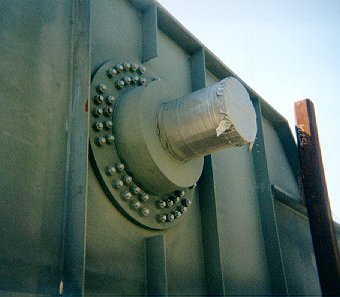|
2012 U.S. Professor of the Year
Professor, OCW advocate, socio-economic diversity champion, one-pony pedagogy assailant, UDL believer, replicating education-research studies supporter.
|
|
|
HOME | NEWS | TEACHING | RESEARCH | STUDENTS | TEXTBOOKS | PUBLICATIONS | NEWS ARTICLES | CONTACT
|
|
Does step-cooling make the trunnion-hub-girder assembly procedure fail-safe? |
|
To assemble the fulcrum of a bascule
bridge, a trunnion is shrink-fitted into a hub, followed by the
trunnion-hub (TH) assembly being shrink-fitted into the girder of
the bridge. To shrink the TH assembly, it is cooled in a
medium such as liquid nitrogen, and during this process in some
cases, the hub cracked. To reduce the possibility of such failures,
a formal design of experiments study is conducted to fin (1) hub outer diameter and (2) the radial interference (at the TH interface), and
different cooling methods such as immersion in (1) liquid nitrogen (2) dry-ice/alcohol bath followed by liquid nitrogen (3) refrigerated air chamber followed by in liquid nitrogen, (4) refrigerated air chamber followed by in dry-ice/alcohol bath and then by in liquid nitrogen
The cooling method contributes the most to increasing critical crack length (between 58% and 79%) and increasing the stress ratio (between 48% and 84%) when considering TH assembly procedures in representative fulcrum geometries. Moreover, the second cooling method, which is immersing the TH assembly into dry-ice/alcohol bath followed by immersing into liquid nitrogen, give larger critical crack lengths (between 262% and 406%) and larger stress ratios (between 17% and 87%) compared to the current cooling method that uses only liquid nitrogen.
Related Papers N. Collier, A.K. Kaw, G.H. Besterfield, M. Rahman, "Benefits of Staged Cooling of Composite Cylinders in Shrink Fitting", The Journal of Strain Analysis for Engineering Design, pp. 349-361, Vol. 41 (5), 2006. |

 on
design parameters such as critical crack lengths and stress ratios.
on
design parameters such as critical crack lengths and stress ratios.